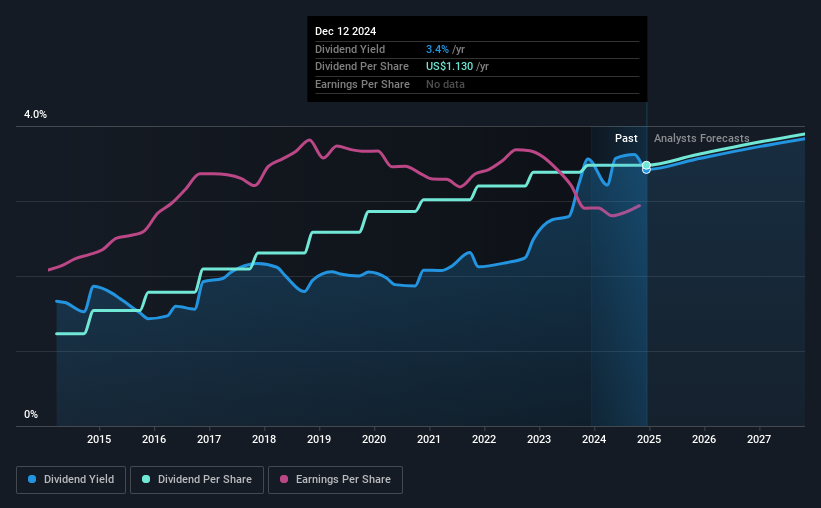Hormel Foods Corporation (NYSE:HRL) will increase its dividend on the 18th of February to $0.29, which is 2.7% higher than last year's payment from the same period of $0.283. This makes the dividend yield about the same as the industry average at 3.4%.
Check out our latest analysis for Hormel Foods
Hormel Foods' Projected Earnings Seem Likely To Cover Future Distributions
We aren't too impressed by dividend yields unless they can be sustained over time. Before this announcement, Hormel Foods was paying out 77% of earnings, but a comparatively small 61% of free cash flows. This leaves plenty of cash for reinvestment into the business.
The next year is set to see EPS grow by 42.2%. Under the assumption that the dividend will continue along recent trends, we think the payout ratio could be 60% which would be quite comfortable going to take the dividend forward.

Hormel Foods Has A Solid Track Record
The company has a sustained record of paying dividends with very little fluctuation. Since 2014, the dividend has gone from $0.40 total annually to $1.13. This means that it has been growing its distributions at 11% per annum over that time. We can see that payments have shown some very nice upward momentum without faltering, which provides some reassurance that future payments will also be reliable.
The Dividend's Growth Prospects Are Limited
Some investors will be chomping at the bit to buy some of the company's stock based on its dividend history. However, things aren't all that rosy. In the last five years, Hormel Foods' earnings per share has shrunk at approximately 4.3% per annum. If earnings continue declining, the company may have to make the difficult choice of reducing the dividend or even stopping it completely - the opposite of dividend growth. Earnings are predicted to grow over the next year, but we would remain cautious until a track record of earnings growth is established.
In Summary
Overall, this is probably not a great income stock, even though the dividend is being raised at the moment. The company is generating plenty of cash, but we still think the dividend is a bit high for comfort. We don't think Hormel Foods is a great stock to add to your portfolio if income is your focus.
Market movements attest to how highly valued a consistent dividend policy is compared to one which is more unpredictable. Meanwhile, despite the importance of dividend payments, they are not the only factors our readers should know when assessing a company. Given that earnings are not growing, the dividend does not look nearly so attractive. Very few businesses see earnings consistently shrink year after year in perpetuity though, and so it might be worth seeing what the 9 analysts we track are forecasting for the future. Looking for more high-yielding dividend ideas? Try our collection of strong dividend payers.
Valuation is complex, but we're here to simplify it.
Discover if Hormel Foods might be undervalued or overvalued with our detailed analysis, featuring fair value estimates, potential risks, dividends, insider trades, and its financial condition.
Access Free AnalysisHave feedback on this article? Concerned about the content? Get in touch with us directly. Alternatively, email editorial-team (at) simplywallst.com.
This article by Simply Wall St is general in nature. We provide commentary based on historical data and analyst forecasts only using an unbiased methodology and our articles are not intended to be financial advice. It does not constitute a recommendation to buy or sell any stock, and does not take account of your objectives, or your financial situation. We aim to bring you long-term focused analysis driven by fundamental data. Note that our analysis may not factor in the latest price-sensitive company announcements or qualitative material. Simply Wall St has no position in any stocks mentioned.
About NYSE:HRL
Hormel Foods
Develops, processes, and distributes various meat, nuts, and other food products to foodservice, convenience store, and commercial customers in the United States and internationally.
Established dividend payer and good value.
Similar Companies
Market Insights
Community Narratives



